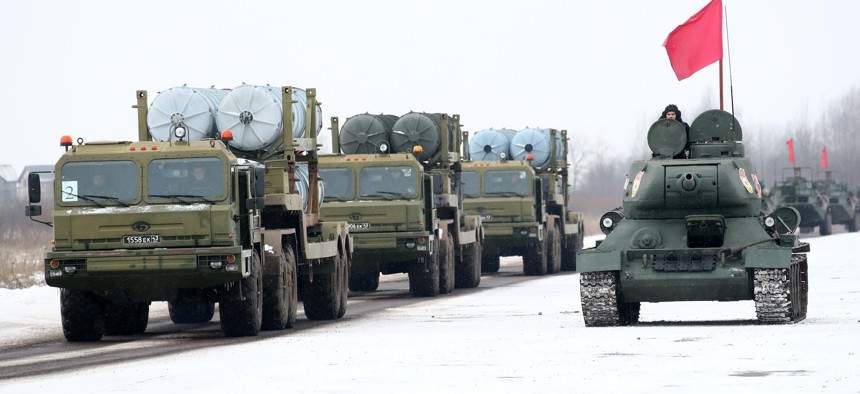
S-300 surface-to-air missile systems of the Russian Army St Petersburg Garrison are seen on Gorelovo Airfield during a rehearsal for a victory day parade in 2021. TASS via Getty Images / Peter Kovalev
US Officials Not Ready to Dismiss Russia’s Anti-Aircraft Missiles, Despite Shortcomings in Ukraine
The U.S. has invested heavily in expensive stealth aircraft that can evade detection from Russian interceptors.
For more than two decades, U.S. military leaders have argued that a combination of stealth aircraft and missiles, combined with invisible electronic weapons, would be needed to defeat Russia’s sophisticated air defenses.
But two weeks into Moscow’s invasion of Ukraine, Russian forces still don’t have control of the skies, allowing decades-old, non-stealthy, Ukrainian Air Force MiG and Sukhoi fighter jets to keep flying. Still, U.S. officials are hesitant to question the technical abilities of Russia’s surface-to-air missiles. Instead, they point to a slew of other factors that have allowed the Ukrainian military to blunt Moscow’s advances. They also point to Ukraine’s successful use of Russian-made weapons in their possession.
“The Russian air defense units … operated by the Ukrainians, they're pretty capable systems,” Gen. Mark Kelly, the head of the U.S. Air Force’s Air Combat Command, said Wednesday at the McAleese and Associates Defense Programs conference in Washington. “The Russians themselves—I think, and think is the key word—is that they're struggling with fighting Russian systems and they're not adhering to Russian doctrine.”
Russian forces have been unable to achieve what the military calls air superiority—basically shooting down any opposing aircraft in the sky. This has allowed Ukrainian fighter jets and drones to successfully strike Russian forces. Controlling the skies is critical, because it allows ground troops to advance without worrying about aircraft bombing them.
“It's surprised everybody, I think, that the Russians have not suppressed the Ukrainian air defenses more quickly,” said Thomas Karako, a missile defense expert at the Center for Strategic and International Studies. “They [Russia] reportedly sent in 500-plus missiles of various kinds, but the reports are that the Ukrainian air defenses, of some kind, and Ukrainian aircraft are still operating. That's really astonishing.”
Russia’s forces in Ukraine have faced well-documented morale and logistics issues. Embarrassing pictures and videos have been posted to social media of abandoned armored vehicles and missile launchers.
“It's clearly performing below expectations at a macro level,” Karako said of Russia’s weapons. “It's hard to judge how it's performing technically when so much stuff is getting abandoned, when they have logistics problems, and all these other tertiary factors going on.”
Despite Russia’s battlefield shortcomings, U.S. officials say that Russia’s missile defenses on its own soil are much more sophisticated. Russian bases are better protected by what Kelly called “layer upon layer upon layer” of sophisticated S-300 and S-400 interceptors.
“They can operate pretty [safely] from their main air bases with that layer of air defense over them,” Kelly said.
Russia also has more than five dozen nuclear-armed interceptors, according to the Pentagon’s 2019 Missile Defense Review. It is also developing the S-500, “an even more modern and technologically advanced air and missile defense system to augment the S-300 and S-400” and has shared missile defense technology with China and Iran, the review states.
Russia’s air defenses, particularly its S-300 and S-400 surface-to-air missile batteries, have driven the U.S. military to invest heavily in expensive stealth aircraft that can evade detection for these interceptors’ radars. It’s planning to spend hundreds of billions of dollars on thousands of F-35 stealth fighters and planning to spend billions on at least 100 B-21 stealth bombers. The Pentagon has also invested in stealthy, long-range cruise missiles that can fly hundreds of miles after being fired. In recent years, Air Force officials agreed to buy new updated, but non-stealth F-15 fighters.
For nearly a decade, the Air Force has been trying to retire the A-10, a slow-flying attack plane with the sole mission of helping troops on the ground. Generals have argued in favor of fast-flying, multirole jets like the F-35 stealth fighter that can strike targets in the air and on the ground. But after several unsuccessful attempts to put the A-10 out to pasture, Air Force leaders have said they will keep the planes around and even install new wings on them.
A similar debate is emerging with MQ-9 Reaper, a high-flying drone that can remain airborne for an entire day gathering intelligence, and bomb targets if needed. Air Force officials say the pilotless turboprop’s major shortfall is its inability to defend itself from surface-to-air missiles.
“The MQ-9 is an uncontested environment type of platform,” Air Force Secretary Frank Kendall said last month in an interview with Defense One. “There are some things you can do to make it less so, but it's still going to be a relatively vulnerable platform with limited capabilities.”




